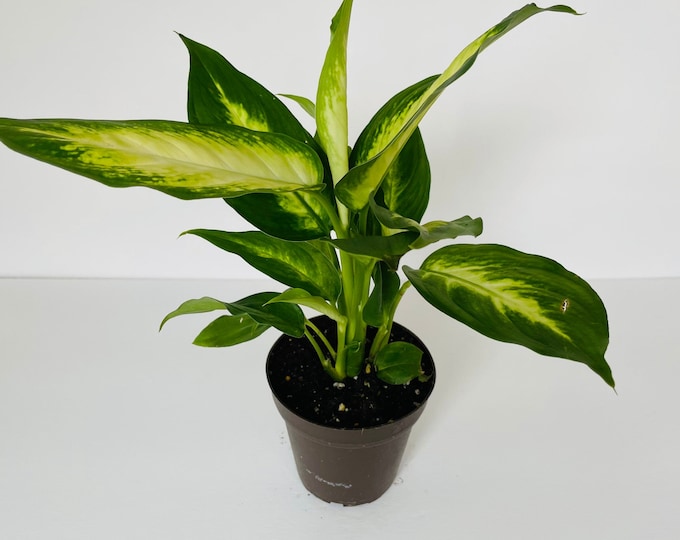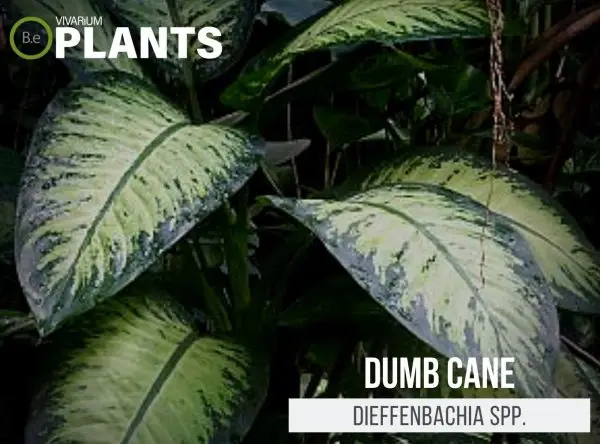Dieffenbachia, also known as Dumb Cane, is a beloved vivarium addition due to its gorgeous foliage.
Its difficulty level is ideal for both beginners and experienced hobbyists. It is safe to keep around pets, being both animal and bug friendly.
Whether it be in a container or planted directly into the substrate, Dieffenbachia is the perfect eye-catching tropical terrarium plant that is fairly low maintenance and requires minimal sunlight.
| Quick Stats: | |
|---|---|
| Scientific Name | Dieffenbachia spp. |
| Common Name | Dumb Cane, Leopard Lily, Tropic Snow, Compacta |
| Family Name | Araceae |
| Habitat | Rainforests, Tropical Areas |
| Temperature | 65°F to 80°F |
| Height | 1 to 6 feet |
| pH | 6.0 to 7.5 |
| Lighting | Bright |
What is a Dumb Cane?
Dieffenbachia is a genus of flowering plants native to the tropical rainforests and jungles of South America, Mexico, and the Caribbean Islands.
The name “Dumb Cane” comes from the fact that if ingested the plant will numb the inside of the mouth.
In addition, the name “Leopard Lily” is attributed to both the shape of the leaves which mimic the shape of a leopard’s spots and to the speckling of green and yellow to the leaves themselves.


Dumb Cane Facts
Dieffenbachia has a lifespan of approximately 1-2 years and has the potential for flowers to bloom in their final stage of life.
It is, however, not unusual for the flowers to never bloom at all.
The plant grows in several varieties such as:
- Dieffenbachia maculata
- Dieffenbachia picta
- Dieffenbachia amoena
- Dieffenbachia seguine
- Dieffenbachia bausei.
Description
Dumb cane is a tropical perennial plant with a wide range of heights from 1 foot to 6 feet.
The leaf color changes depending on the variety from bright yellow, green, pink, and white.
The leaves are large and vary in size, shape, and markings. The plant’s leaves can resemble those of a banana tree.
They are glossy in appearance and pinnately veined.
Habitat
Dumb cane flourishes in areas with high humidity and warm temperatures.
The ideal temperatures it prefers are between 65°F to 80°F and should not be exposed to temperatures lower than 50°F.
It is capable of surviving light frost but sustained low temperatures will cause it to die off.
The plant prefers bright, indirect sunlight and prefers an area away from ceilings, furniture, and walls.
PH Preference
Dieffenbachia prefers an acidic environment with a pH range of 6.0 to 7.5.
Low pH causes the leaves to yellow, and high pH causes the foliage to discolor and the plant will eventually die.
The plant requires an already established pH and requires regular checking, as any changes in the pH can cause stunted growth and discoloration.
Vivarium Type
The dumb cane is quite an easy-going species. With that in mind, it will not be too complicated when it comes to choosing the type of enclosure it is grown in.
It is best to try and replicate the plant’s natural habitat as much as possible.
Doing so will make it easier to provide this tropical plant with its basic needs.
The proper setup and theme of the enclosure will make a big difference to the overall look and health of the plant.
Be sure to choose setups that are moist and high in humidity. Here are recommended vivariums it will do well in:
- Paludariums – Half aquatic/ half terrain-based enclosure.
- Terrariums – Fully terrain-based enclosures with little to no aquatic features.
Vivarium Placement
Dumb cane does well when planted in a loose texture substrate as there is no additional weight for it to handle.
While it is preferable to use a loose texture substrate, it will also do well in a firmer substrate with a higher mineral content and good drainage.
The soil should also be kept moist at all times, but not overly saturated and waterlogged.
The plant can also be placed in a container suspended above the substrate but readjusted to a lower height as the plant continues to grow.
Substrate
Substrates with high mineral content and good drainage are what Dieffenbachia will thrive in.
A necessary factor to be aware of is the drying and wetting cycle, which is common in tropical vivariums with high humidity.
The terrarium soil should not be allowed to remain submerged in water for too long, as this could cause root rot.
Lighting
Light is a major part of dumb cane’s growth and it should not be exposed to direct sunlight as this will cause burning.
Instead, aim for a sunny window or provide a proper bulb that is capable of supplying the necessary light needed.
Fluorescent, LED, and T5 lighting are the most suitable and the goal should be towards 8-12 hours of terrarium-type lighting and 12-14 hours of darkness.
Buy Dumb Cane
When it comes to buying leopard lily, there are a few things to keep in mind. Making sure the plant is healthy when purchased is essential for its success in a vivarium.
Vegetation that is already in poor conditions will have a very hard time adjusting to new environments.
Click the image below to find out more about the current price and other relative info about this plant.


Dumb Cane Care and Propagation
Care for Dieffenbachia is fairly easy, with water and light being the two most important factors.
The plant should be watered consistently, with the soil only drying out halfway between waterings.
When it comes to fertilization, this should only be done when necessary with a balanced fertilizer.
When pruning is needed, do so at the base of the stem and above the leaf set.
Propagation happens through cuttings and can be started with a leaf and a node.
Place the cutting on a moist substrate, allowing the leaf to emerge, or wait for a root to form.
How to Grow
To cultivate and nurture a healthy dumb cane plant, a well-draining, light potting mix should be used.
Add fertilizer but keep in mind that different varieties of the plant may need different fertilizers.
Water the soil well until the water begins to come out of the drainage hole and avoid constantly moist soils to avoid root rot.
For best results, place the plant near a bright, yet indirect light window and provide 8-12 hours of light and 12-14 hours of darkness every day.
Watering
Water Dieffenbachia when the top inch of the soil feels dry. Avoid letting the soil become too wet as this could cause root rot.
Make sure the water is free of fluoride, chlorine, and other harsh chemicals as these can cause toxicity to the plant.
It is best to use rainwater, deionized, or distilled water for optimal growth and health.
Plants Similar to Dumb Cane
Adding diversity to an enclosure is key to an aesthetically pleasing setup.
Try mixing up the look of your vivarium with different flora that can easily co-exist in the same types of environment.
Furthermore, if for some reason you find Dieffenbachia hard to acquire or would like to consider something similar to this plant…
Here are other foliage plants you might find will do well with or in the place of leopard lily:
Conclusion
Dieffenbachia Dumb Cane is a lovely accent plant that requires minimal care.
It is a low-maintenance plant that can not only brighten up the vivarium but also provide safety and comfort for some inhabitants.
Being pet and bug friendly, this plant is easily adaptable to different drops and levels of humidity in a vivarium.
With proper conditions in mind, this plant can live happily and grow vigorously with its lush foliage.
Frequently Asked Questions
No, Dumb Cane (Dieffenbachia spp.) does not need a lot of light. It prefers medium light, such as indirect sunlight or bright, filtered light indoors.
The Dumb Cane (Dieffenbachia spp.) gets its name from the fact that it produces an irritating sap when broken, causing temporary vocal paralysis or “dumbness“ in people who consume it.
Yes, Dumb Cane can purify air. This popular houseplant helps to absorb pollutants such as formaldehyde, benzene and trichloroethylene from the air. It is known to improve air quality and can be very beneficial in improving indoor air quality.
Dumb Cane (Dieffenbachia spp.) typically live for 5–6 years under the right conditions.
Yes, misting your Dumb Cane is recommended to increase humidity levels and help the plant to thrive. Keeping the humidity level between 50-70% is best for your Dumb Cane. You can mist it every two to three days, or as needed.



